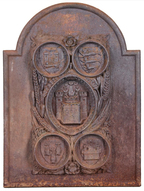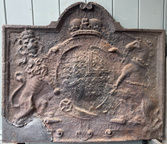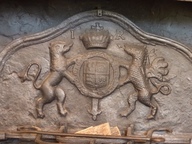-
1193
Description: Arched rectangular shape with a 'flame' on each shoulder and a broken one on top of the arch; fillet and cavetto-moulded edging; lower centre, shield with impaled arms, dexter two bars in high relief, sinister a crowned lion rampant, all in front of a foliate cartouche terminating in mirrored swirls below the shield; above, a beaded coronet; in the arch, the date split either side of mirrored foliate swags suspended from a bow and from a flower in each shoulder, with a short central vertical swag above the coronet.
Notes: A fireback in high relief with an inserted date.
Inscription: 16 62
Arms: not known
- Decoration tags:
- rectangular with round arch (shape)
- fillet and cavetto (edging)
- whole carved pattern
- individual numbers
- heraldic
- armorial
- text
Manufactured: in 1662 in France.
Current location: English Salvage Ltd, North Road, Leominster, Herefordshire, England.
- Attached to series:
- Foreign armorial firebacks
-
1266
Description: Arched rectangular shape; plain edge with 49 large beads parallel with top and sides; upper centre, date in bold Arabic numerals; below date, raised rectangular panel with chamfered sides and corners and fillet edging, and a symmetrical sunburst and rainbow design in low relief.
Notes: Modern, quasi-Art Deco design
Inscription: 1995
- Decoration tags:
- rectangular with round arch (shape)
- none (edging)
- whole carved pattern
- individual numbers
- text
- objects
Manufactured: in 1995 in England.
Current location: in private hands Croydon, Greater London, England.
- Attached to series:
- Miscellaneous pattern firebacks
- 1990s Art Deco series
-
340
Description: Arched rectangular shape; gadrooned edging (top and sides); initials, in separate stamps, at top of arch; date in separate stamps, split by central spindle, below; two different spindles used as stamps, one centrally between splitting initial stamps, the other repeated twice on each side, slightly lower; above each spindle a fleur-de-lys stamp.
Notes: It is possible that the initials were intended to be 'BW' but that it was forgotten that they needed to be reversed when impressed into the mould. The same base board has been used for other firebacks dating from 1622 and 1632, and the central spindle can be be seen on another fireback of 1644. Purchased by J. H. Every at Bigges Farm, Cuckfield, Sussex, in 1918.
Inscription: W B / 16 44
- Decoration tags:
- rectangular with round arch (shape)
- gadrooned (edging)
- simple stamps
- individual letters
- individual numbers
- text
- objects
Manufactured: in 1644 possibly at Cuckfield Furnace in the Weald area of England.
Current location: not known.
Citation: Hughes, G. B., 21 Apr 1955, 'Old English Firebacks', Country Life, 117, pp. 1056-60.
Citation: Hughes, G. B., May 1940, 'Old English Firebacks', Apollo, 31, 185, pp. 117-120.
- Attached to series:
- Spindle series
- Spindle/distaff firebacks
-
41
Description: Arched rectangular shape; rope edging (top and sides); Tudor royal shield, garter, crown and supporters (crowned lion and dragon); date above crown; empty motto compartment with initials below.
Notes: Identical arms can be seen on fireback formerly at Baynards Park, Cranleigh (no. 200), and on one in private hands at Maresfield (no. 482), neither of which have the motto compartment; minor variations in the position of individual elements indicate that the garter and shield, crown, and each supporter were separately stamped; the initials are likely to be those of Henry Bowyer, ironmaster (d.1588), the fireback perhaps being made in his memory.
Inscription: 1588 HB
Arms: Tudor royal (Elizabeth I)
- Decoration tags:
- rectangular with round arch (shape)
- rope (edging)
- carved stamps
- individual letters
- individual numbers
- armorial
- royal
- text
- objects
Manufactured: in 1588 possibly at Pounsley Furnace, Framfield in the Weald area of England.
Current location: in private hands, Cuckfield, West Sussex, England.
-
893
Description: Rectangular with complex quasi-arched rectangular top; ovolo moulded edging; shield with Royal arms of France in a swirled cartouche, initials inserted at top of shield; above, an English crown; below to right and left, a prancing stag.
Notes: The combination of the English crown and French arms is common and may relate to the marriage of Charles I and Princess Henrietta Maria of France in 1625; although the framing of the pattern is very similar to others of the same basic design, the style suggests a different pattern maker. A recasting of an earlier back with inserted initials.
Copies of this fireback are known.
Inscription: IT
Arms: France modern
- Decoration tags:
- rectangular with round arch (shape)
- ovolo (edging)
- whole carved pattern
- armorial
- text
- animals
Manufactured: in the early- to mid-17th century possibly in the Weald area of England.
Current location: not known.
- Attached to series:
- Anglo-French armorial firebacks
-
273
Description: Rectangular with twisted rope edging top and sides; central arch with twisted rope edging; date in arch (8 with flattened top); initials repeated in top corners.
Notes: An unusually large plate to have such simple decoration.
Inscription: 1648 / TK TK
- Decoration tags:
- rectangular with round arch (shape)
- rope (edging)
- individual letters
- individual numbers
- text
Manufactured: in 1648 in England.
Current location: in private hands, Dorton, Buckinghamshire, England.
- Attached to series:
- Date & initials firebacks
-
1134
Description: Arched rectangular shape; astragal edging; central, vertically orientated, rectangular design comprising four circular copmpartments each containing a shield, surrounding an oval central compartment containing a castle surmounted by a crest of a hand between leafy branches all emerging from a mural crown, above is a crescent mark of cadency; the compartments are set within ears of corn with a flower head top and bottom centre.
Notes: The central design is a cast of the pattern for two panels, one on each of the pedestals of the outward-facing main columns on the Norwich Gates at Sandringham House, Norfolk. The shields are of Norfolk towns: (top left) Norwich, (top right) Great Yarmouth, (bottom left) King's Lynn, and (bottom right) Thetford. The central arms are those used by the county of Norfolk (before its official grant of arms in 1904) with the crest of the then Sheriff, Robert John Harvey of Crown Point Norwich. The gates were designed by Thomas Jeckyll and made by Messrs Barnard, Bishop and Barnard of Norwich for the International Exhibition at South Kensington in 1862. With some modifications, including the addition of the panel on the fireback, the gates were given by the people of Norfolk to the Prince and Princess of Wales (later King Edward VII and Queen Alexandra) as a wedding gift in 1863. The design on the fireback was impressed into the mould from a panel originally used in the casting of the gates. Lot 183, Dreweatts sale, Newbury, 5 June 2019.
Arms: City of Norwich, Borough of Great Yarmouth, Borough of King's Lynn, Borough of Thetford, County of Norfolk
- Decoration tags:
- rectangular with round arch (shape)
- astragal (edging)
- carved pattern panels
- heraldic
- armorial
- plants
Manufactured: in the mid- to late-19th century probably at Norfolk Ironworks, Norwich, in the Norfolk area of England.
Current location: not known.
- Attached to series:
- Miscellaneous stamp firebacks
- Commemorative firebacks
-
1312
Description: Arched rectangular shape with small rhomboidal flanges in the corners of the arch, the top of the arch comprising two opposing loops; cavetto moulded edging; crowned circular shield within a Garter of the Stuart royal arms of England with crowned lion and unicorn supporters.
Notes: One of several variations of the arms of the Stuart royal dynasty on firebacks. Duke's auctioneers, Dorchester, Dorset, 10 Jun 2025, lot 9.
Copies of this fireback are known.
Inscription: [Garter and royal mottoes illegible]
Arms: English Stuart royal
- Decoration tags:
- rectangular with round arch (shape)
- cavetto (edging)
- whole carved pattern
- heraldic
- armorial
- royal
Manufactured: in the mid- to late-17th century in England.
Current location: not known.
- Attached to series:
- Stuart royal armorial firebacks
-
1064
Description: A rectangular field with a central circle containing a fouled anchor, the rope gathered in eleven loops around it; in the top spandrels the initials HH, on the left, and IH, on the right; below the circle, the initials IM inset in a square; on each side, a strapwork Ionic pilaster formed of alternate hollow squares, with a pyramidal infill in low relief, and hollow circles; outside each pilaster, a crouching stylised humanoid figure, facing inwards, disgorging a fructed vine; above the figures two opposed volutes, forming part of the edging; above the central field, a semi-circular compartment containing a bird, its wings inverted, and three hollow diamond shapes irregularly arranged; the date above the bird; protruding from the edging above each pilaster is a small, inward-facing scroll. Three vertical plank lines can be discerned, one in front of the right-hand figure, one through the I of the initials IH, and one to the right of the second H of the initials HH. The whole design is in low relief.
Notes: This is a reworking of a design seen on a fireback of 1608 (no. 585) though intentionally stylised. The decorative elements have yet to be fully interpreted; on the 1608 version the figures are fauns, the vines disgorged from their mouths being related to the 'green man' tradition associated with woodland spirits and symbolising resurrection, the latter echoed by the bird which, on the earlier version is a phoenix. However, in the form in which they appear on both firebacks they may be purely decorative devices. By contrast, the cabled anchor is the badge of the Lord High Admiral but in 1633 the office was vacant. The initials IM indicate that this is an early work by a prolific fireback pattern-maker more usually associated with the eastern Weald.
Inscription: 1633 / HH IH / IM
- Decoration tags:
- rectangular with round arch (shape)
- fillet (edging)
- whole carved pattern
- planklines
- pictorial
- mythological
- text
- animals
- humans
- plants
- objects
Manufactured: in 1633 in the Weald area of England.
Current location: Pound Farm, Common Road, Dunsfold, Surrey, England.
Citation: Wall, J. R. S., 20 May 1965, 'Wealden Fireback' [letter], Country Life, p. 1208.
- Attached to series:
- IM series
- Brede group
-
1213
Description: Rectangle with curved shoulders and low arch joined with concave curves; fillet and ogee moulded edging; central Tudor royal shield surrounded by garter, with crown above and lion and dragon supporters; royal initials either side of crown.
Notes: On other castings of this fireback the initials are 'ER', the 'I' for James having been substituted here for the 'E' for Elizabeth but incorrectly retaining the Tudor shield. The garter motto includes ‘EQVI’ instead of ‘HONI’, making it meaningless; possibly ‘EQVI’ was a mis-transcription of ‘HONI’; the crown is distinctly continental in form.
Inscription: I R
Arms: Tudor royal - Edward VI or Elizabeth I
- Decoration tags:
- rectangular with round arch (shape)
- fillet and ogee (edging)
- whole carved pattern
- individual letters
- heraldic
- armorial
- royal
- text
Manufactured: in the early-17th century in England.
Current location: Prior's Hall, Durham Cathedral, Durham, County Durham, England.
- Attached to series:
- Jacobean royal armorial firebacks
- Garter error series
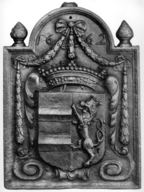
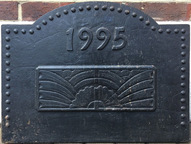
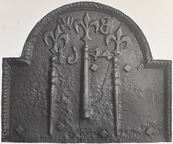

 23-10-12 686x.jpg)

